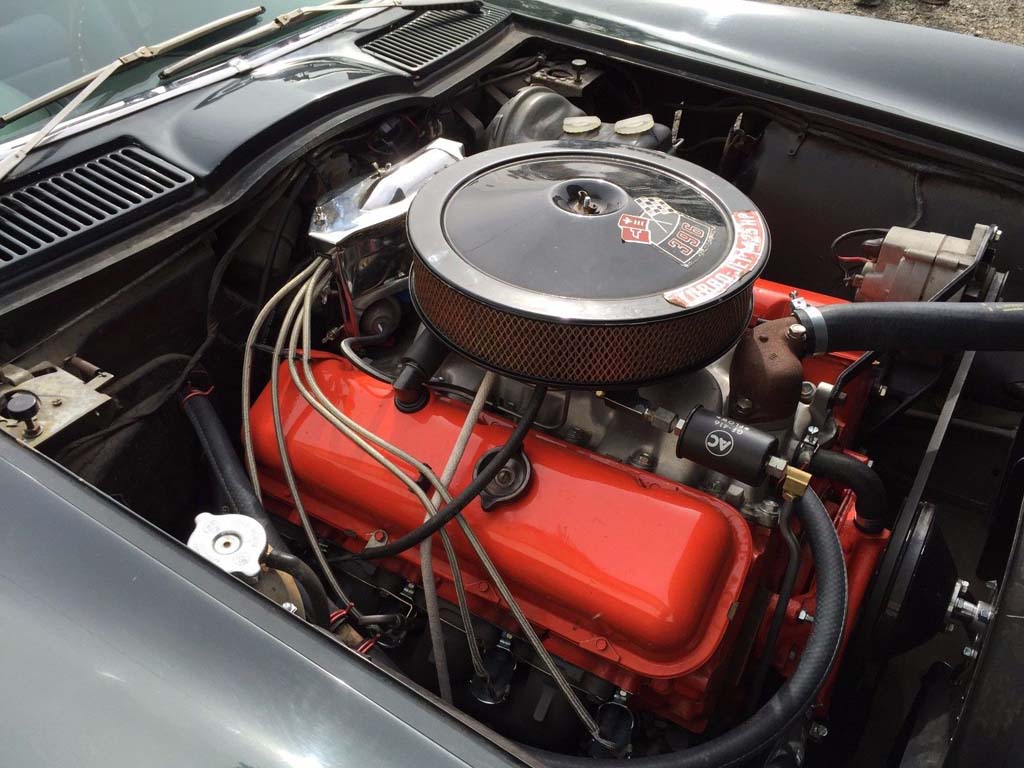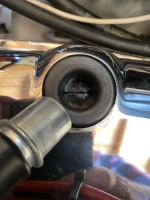Thanks for your reply, Ken, sounds like you put some thought to my problem.I apologize for this late reply. You have a beautiful car with good engine components. Having the car mark your driveway every time you drive it isn't going to work. I disagree with many of the replies as this isn't a junk car that you're trying to "poor boy" some extra life out of. My thoughts are as follows:
Don't fill the engine with extra heavy oil, as this will cause an oil drain-back issue with the oil in the valve covers not making it to the oil pan in time. Same with using less than 5 quarts of oil in the oil pan. Both lead to spinning rod bearings.
You're likely going to need to disassemble this engine to fix the issues. Look for worn valve guides, as most machine shops assemble the heads to verify all of the components are returned. I've generally seen dry valve guides filled with metal filings than need to be cleaned out prior to assembly. Also, while you take the engine apart "plastigage" the main and rod bearings. Tight is good, loose clearances cause windage losses and lower the operating oil pan level. Verify the ring gap and verify that the piston ring grooves are perpendicular to the side of the piston. If the ring grooves are trapezoidal, even a little, then the rings won't seal. Piston wall finish, if the bores weren't torque plate honed, then they won't be round when the heads are torqued. Without this process you will likely see oil consumption of 1 qt per 1000 miles, probably not a big deal. While you have the engine apart, verify that the pistons go even to the top of the block, (the factory machining is 0.030" down on one end with 0.070" one the opposite end). If so, have the engine deck machined to a 0.000" piston/block deck height. It's not an oil consumption issue, but an extra power/torque issue. Also, if you want, verify or change the cam to sightly less duration with a 106 degree lobe separate angle. This will add low end torque without losing anything on top.
Best of luck, if you need or want a means of calculating dynamic compression, let me know, I have an Excell spreadsheet that I made years ago.
You are using an out of date browser. It may not display this or other websites correctly.
You should upgrade or use an alternative browser.
You should upgrade or use an alternative browser.
Oil for my 496 BBC
- Thread starter 496BBC
- Start date
Beautiful car.
Corvette BB valve covers were painted orange until 1968 when they were chrome plated. Original valve covers are failry heavy and have drippers; aftermarket may not.
If the engine is leaking, you would see it.
If that is a square bore Corvette intake with the Winters casting, it is likely a very valuable Corvette low rise Holley mainfold. They were used on the LS6 454 engines and a few others. Most BB Corvettes had the low rise for the Q-Jet.
I don't know that much about the 1 year only 1965 396 Corvette engine, but a 427 and bigger is a better engine.
Here's the 65 396:

Corvette BB valve covers were painted orange until 1968 when they were chrome plated. Original valve covers are failry heavy and have drippers; aftermarket may not.
If the engine is leaking, you would see it.
If that is a square bore Corvette intake with the Winters casting, it is likely a very valuable Corvette low rise Holley mainfold. They were used on the LS6 454 engines and a few others. Most BB Corvettes had the low rise for the Q-Jet.
I don't know that much about the 1 year only 1965 396 Corvette engine, but a 427 and bigger is a better engine.
Here's the 65 396:

Last edited:
Beautiful car.
Corvette BB valve covers were painted orange until 1968 when they were chrome plated. Original valve covers are failry heavy and have drippers; aftermarket may not.
If the engine is leaking, you would see it.
If that is a square bore Corvette intake with the Winters casting, it is likely a very valuable Corvette low rise Holley mainfold. They were used on the LS6 454 engines and a few others. Most BB Corvettes had the low rise for the Q-Jet.
I don't know that much about the 1 year only 1965 396 Corvette engine, but a 427 and bigger is a better engine.
Here's the 65 396:

I’m back home now and ready to remove the valve covers but first want to install a breather cap and plug the PCV hose And check that out. My intake is a 3963569. Is that a desirable intake?
Pretty valuable. It is the low rise BB square bore (Holley flange) rectangular port manifold. Used in the hi-po big blocks. Casted at the Winters foundry. There were a bunch of copies made. Getting a BB and carb to fit in the Corvette engine bay, which was designed for the small block, was a good trick.I’m back home now and ready to remove the valve covers but first want to install a breather cap and plug the PCV hose And check that out. My intake is a 3963569. Is that a desirable intake?
Now these are not the best performing, as the low rise limited the flow potential. Do not over-cam it as you will starve that cam. I had one in a 70 Vette with a CRR LS6. 780 Holley. 4 to 6 mpg. Brutal. Your engine has the potential to blow away any 396. I would do a mild rebuild to shore up any leaks, and stab a nice mild hydraulic roller.
The small blocks are better balanced and are fairly good drivers. But the big blocks rule! Here's mine:
I’m looking at replacement valve covers. What are ”dripper rails” and would they help my PCV system?
they are metal rails inside the valve cover that catch oil and let it drip back to the head, they might help some, but properly baffled is most important IMO.
Here's an example (click on the picture that shows the inside). I'm not recommending this vendor, i just found it googling.
https://www.assaultracing.com/item/1213768-bbc-pwr-brk-orange-short-vc-dripper-rai?category=8015
I apologize for not getting back sooner but a lot has been going on since my last post. Anyway, finally was able to get back on the car yesterday, pulled #8 cylinder plug and the PCV valve. The valve surprised me, there was absolutely no oil in there, not even oil film. Every car I’ve ever had had an oily PCV valve. Not sure what to make of it. Going to get a different PCV today and try it. Also going to run a vacuum test on that hose. Any comments or ideas?
Attachments
that's a baffled PCV grommet ...
Does that contribute to my oil consumption problem?that's a baffled PCV grommet ...
Put an O2 probe in the exhaust and see what the air/fuel ratio is while driving.
It could be pig rich while just cruising at light throttle.
That would wash the oil off the cylinder walls.
This could be your oil consumption issue.
Get a Zeitronix. Works well for the money.
It could be pig rich while just cruising at light throttle.
That would wash the oil off the cylinder walls.
This could be your oil consumption issue.
Get a Zeitronix. Works well for the money.
If they are so bad, why does it run so well???Those spark plugs look terrible. That engine is sick.
I don’t know why there are fibers there, perhaps from the rag I wiped them with. Do you think those fibers would actually survive combustion? Other than a carbon buildup, I don’t see all that much wrong with them. Please clarify.What are those fibers all over the spark plug? No matter the case, something is wrong. Those plugs looks pretty bad. Did you pull the valve covers?
The PCV rubber grommet looks like it could be blocking the small hole in the PCV valve - looks like the grommet has a mere slit across the diameter. If vapors are being sucked through the valve and hose, there should at least be some evidence of an oil film from the oil vapors. maybe try not pushing the PCV valve all the way down into the grommet. That PCV valve looks to already have a flow control orifice in it - GM went with that style on their newer PCV valves. In fact, that valve may not even have a spring loaded plunger, but it's simply and orifice hole to control the vapor flow rate.Does that contribute to my oil consumption problem?
I was just curious what the fibers were. Maybe it’s the picture lighting but the threads looks oily. Also you need to cut the pcv grommet at the bottom so air can escapeI don’t know why there are fibers there, perhaps from the rag I wiped them with. Do you think those fibers would actually survive combustion? Other than a carbon buildup, I don’t see all that much wrong with them. Please clarify.
Maybe Chuck Norris used to own that car and the spark plugs don't dare stop firing.If they are so bad, why does it run so well???
I didn’t like the grommet either so bought an open one today and also a regular PCV valve.I was just curious what the fibers were. Maybe it’s the picture lighting but the threads looks oily. Also you need to cut the pcv grommet at the bottom so air can escape
Similar threads
- Replies
- 13
- Views
- 445
- Replies
- 21
- Views
- 1K
- Replies
- 11
- Views
- 290
- Replies
- 26
- Views
- 649





